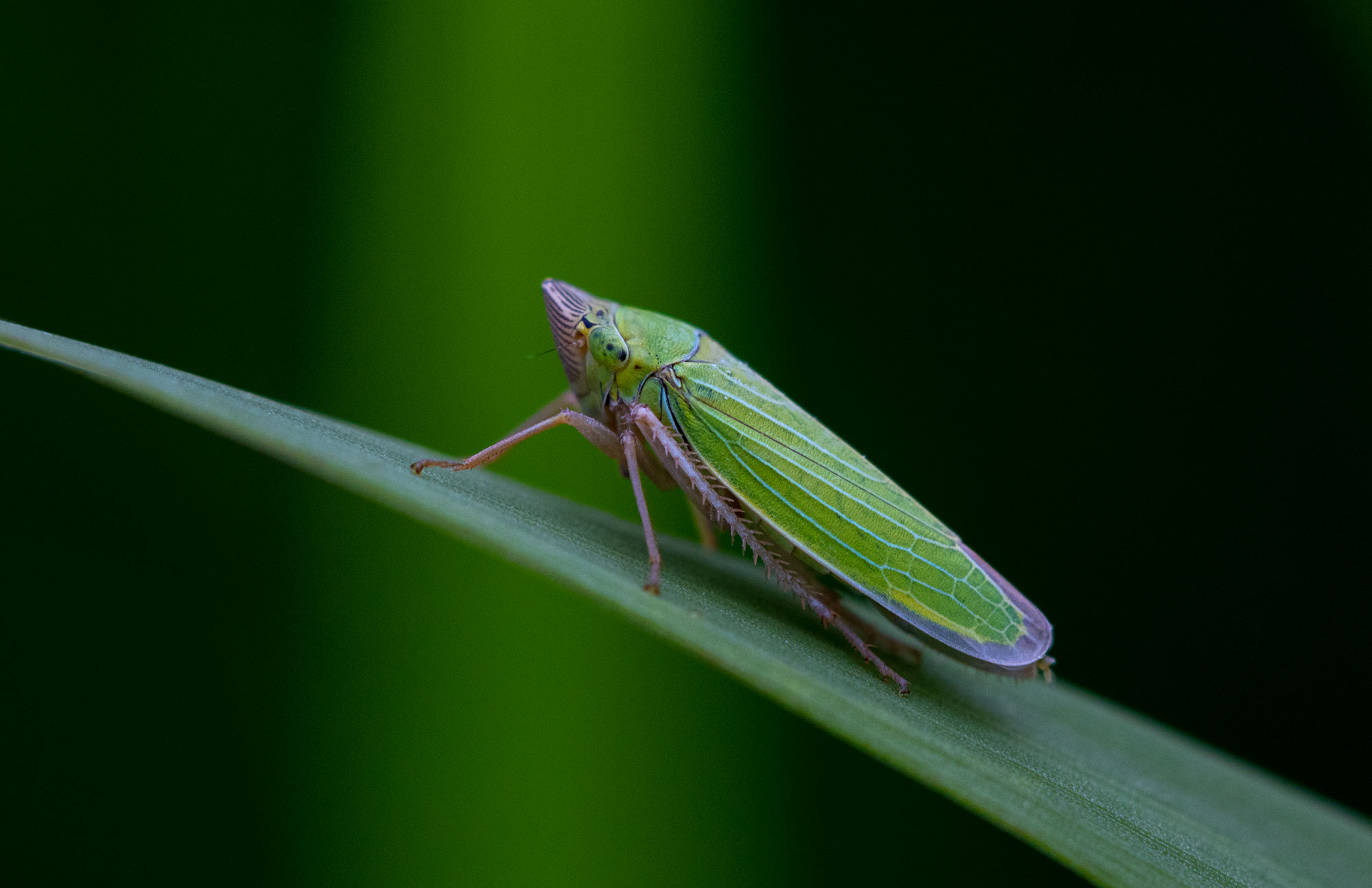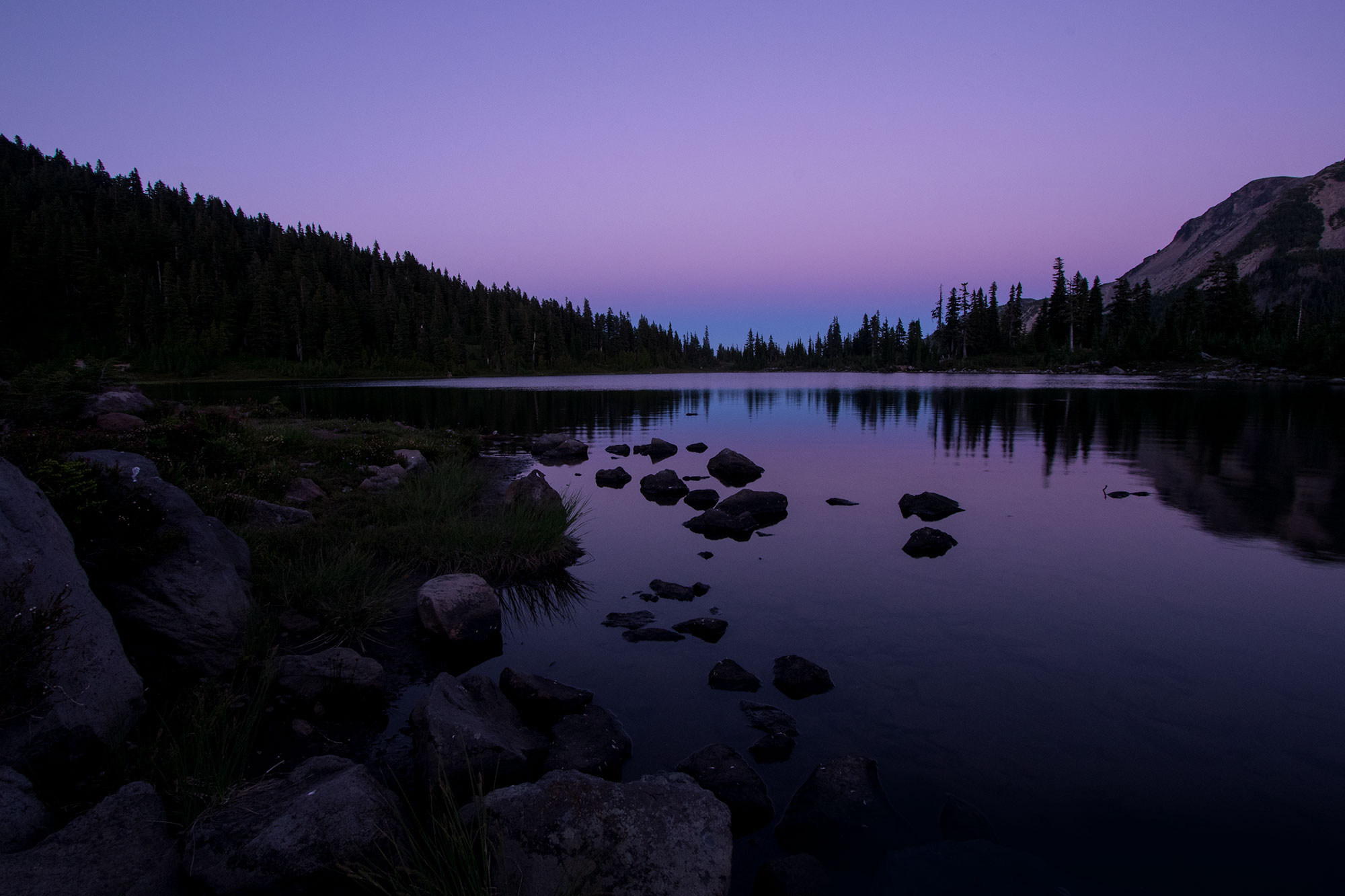The idea of survival permeates American culture, even as we veer farther away from it in our daily lives. When hurricane season comes around, we can hear it in the voices of those who decided to stay behind. I just know how to survive…we’re survivors out here in this part of the country…whatever nature decides to give us, we’ll take it on.
Sometimes, backpacking is presented as a form of survival. You go out into the wilderness for a few days and survive the elements. I’m sitting on a jumble of boulders at the crest of Park Ridge with my two hiking mates, Tim and Eric, looking out at the 10,500 foot Mount Jefferson, and the lush Jefferson Park wilderness at its base. While eating my lunch, I realize that I feel something that I consider to be the exact opposite of survival.
I have no dishes to do, nowhere to be, no texts to read, no responsibilities. For a short weekend, my life is on my back, and this sort of carefree feeling comes over me, maybe similar to waking up as a child on a midsummer day and having nothing to do.
Backpackers talk about the central challenge of keeping pack weight to a minimum. Now, I feel the end result of that. With a light pack, I have food, water and shelter covered; I am a mobile, self-contained version of myself. That feeling, again, is not one of survival, but simple carefree freedom.

The lush meadows of the Jefferson Park wilderness are rich in alpine wildflowers, mosses, butterflies and other insects, like this leafhopper sitting on a blade of grass.
It’s all downhill from here; we’ll set up camp along the grassy shore of one of the many lakes in the Jefferson Park wilderness below. As we descend, we’ll walk into an increasing profusion of wildflowers and butterflies.
Edith’s Checkerspots, black, red, yellow, orange and white butterflies, are abundant. I often think of this butterfly as the Pacific Northwest’s most beautiful, especially when its wings are folded up and a bold cubist mosaic is revealed.
The Edith’s Checkerspot has been in sharp decline at the southern and northern edges of its range. In Baja California, it has become locally extinct in low elevations, and in British Columbia, it has disappeared from the high elevations. It’s decline and local extinctions are explained by shorter seasons of favorable conditions in a warming climate.
As we descend, we pass several thru-hikers. We are on the Pacific Crest Trail after all. When I stop to talk to one of them, I can’t help to notice his pack, which is half the size of mine, and his shoes, which are just sandals, and his water bottle, which is just a regular old water bottle.
He tells me he has been walking for thirty days. He started in Northern California and had seen good weather the entire trip up. He had been thinking all day about making it to Olallie Lake, where, he says, he might enjoy a beer.
“Honestly,” he explains, “a lot of thru-hikers get these cravings. I don’t. I just eat whatever crap I can get.”
In his early sixties, this thru-hiker is on his second year of the Pacific Crest Trail. Next year, he will make it to the Canadian border in Washington. He is the eighteenth thru-hiker we’ve passed today, suggesting the popularity of the long walk.
You can tell the thru-hikers right away. Their packs are small, and they seem light on their feet. Again, this reminds me that being in this alpine wilderness isn’t about survival, but being carefree.

Russell lake in the Jefferson Park wilderness.
At night, tired from the walk up, I am wandering in and out of sleep in my small tent pitched under trees next to a shallow lake. I try to listen attentively to my two hiking mates, Tim and Eric, while they look out at the night sky, using phone apps to identify different stars, constellations and nebulae.
When they say the international space station will pass overhead in exactly two minutes, it does just that, making an arc of dim light across the darkening sky.
It’s hard to imagine men and women working up there, in little tubes throttling around the Earth. On a different day, I might remark to myself on this achievement of mankind; one of science, math, engineering, systems and institutions.
But actually, in my last moments awake, I am pondering why I am so surprised to hear these two grown men talking about the stars; exchanging a shared passion for observed science.
I am surprised, even taken aback, when adults appear to be at ease discussing the natural world. I can hear that passion on NPR’s Science Friday, or in a David Quammen book or a BBC documentary, but something about it feels unfamiliar when I observe it among friends.
I tried to get into Oregon’s Jefferson Park wilderness for the past couple years, but climate kept getting in the way – first forest wildfires, then a snowpack that lasted into late August, and then wildfires again.
The wildfires last year ravaged the main trails into the area, closing them until future restorations. You can still access the Jefferson Park wilderness on the Pacific Crest Trail, the route which we took to get here, but the whole way up offers views into those blackened canyons.
There were nearly 2,000 wildfires in Oregon last year, burning an area the size of Rhode Island. The largest of the fires surrounding Jefferson Park, the Whitewater fire, burned thousands of acres of mountain canyon, rendering views of bare trees for much of the entire walk up into the Jefferson Park wilderness.
I’ve been thinking a lot lately about what it means, or what it should mean, to be outside and to see, and witness the evidence of these events, and how we should consume the information that we see with our own eyes. This seems to be the year when people have taken notice of the increasing weather events around the world; a key sea change in the battle for the world’s understanding of climate change has occurred because people are connecting dots from personal observation.
Earlier this summer, a family guest admitted that he didn’t believe in climate change science. Since he was intelligent and thoughtful, how was this possible?
It turns out that he had formed his opinion on climate change after reading State of Fear, a case against climate change costumed as a science fiction thriller by the Jurassic Park author Michael Crichton. Leary of the science behind climate change, our guest said: everybody is trying to sell me something.
I wrote him back with a detailed explanation of why State of Fear was a work of pseudoscience and antiscience, and therefore the very worst sort of place to get information on climate change. But all summer, I was bothered by the realization of how common it was to find my very own adult friends getting sucked into alternatives to science on all sorts of questions that should only be addressed by science.
In my explanation, I talked about how I consume science media, how I learn to differentiate between high and low quality science journalism. But my answer bothered me as being incomplete, and our guest’s retort: everybody is trying to sell me something kept stewing in the back of my mind.

Walking into the Jefferson Park wilderness. 10,500 foot Mount Jefferson is in the background.
The next morning, I wake and walk to the nearby stream to refill my water. On a small plant in the wildflower meadow, I notice a flash of lime green. I know immediately what it is. A tiny, grain-sized leafhopper, aware of my presence, had just shifted its position to the other side of the plant’s stalk.
Over the years, I’ve trained myself to notice that little flash; I hardly ever miss a leafhopper these days. I first noticed them about ten years ago, when my son was an infant and I spent more time on my hands and knees in the grass. But as I began to take on an interest in their diversity and colors, I would seek them out wherever I went. In Ecuador’s Andean highlands, I found species in illuminating shades of blue, and in Peru, I found one individual as brilliantly multicolored as a lorikeet.
Slowly, through a personal interest, I gained a layman’s understanding of a little slice of our world. In this personal pursuit, nobody ever tried to sell me something. Leafhoppers aren’t particularly controversial. They aren’t like coffee or fad diets; with competing studies vying for my attention. To learn about them, there is only one place I can go – science. There is no Fox News host to give me an alternative explanation, there is no quack naturalist to tell me not to believe in leafhoppers, and there is no Alex Jones, inciting conspiracies about leafhopper invasions.
There is no other way I can find my information about leafhoppers except through science. As I passively work my way through my observations and casual learning, I notice at one point that I can communicate clearly with an entomologist about them.
I remember Eric and Tim, looking up at the stars and asking questions. Like my leafhopper, their celestial questions can only be answered by science.
As we work our way up the ladder of our own personal explorations of the natural world, we gain more confidence in our understanding of scientific subjects, and it becomes easier for us to differentiate between science and its competitors. Once you’ve found your answers to the stars and the leafhoppers through science, all along with nobody trying to sell you on any politics or products, you learm how to see the difference.
Most people, as intelligent and thoughtful as they may be, never get the chance to work their way up the ladder of science. They have no tools to differentiate between the systematic knowledge-building, the peer-review process and the scientific method of science, and its masked imitators.
As we live in a complex, modern world with complex, science-based issues, we have to remember how scientifically illiterate we are. When there is a market for an alternative to science, somebody will be there to sell you on that alternative.
But the antidote out there – the thing that is gonna make people find their answers to complex issues like climate change, is to encourage them to get outside, take a walk, and connect the dots.
When I return to camp, two female backpackers pass by. They are packing out, and on their way towards the trailhead, but they’re a bit worried about the drive off the mountain.
We had taken one of the roughest talus-covered roads I have ever driven on to get to the trailhead; all sweat and nerves and sending the three of us bouncing in our seats. We explain to the backpackers how we, too, were mortified by that road.
We recount the story of how when we made it to the trailhead, we were surprised to find a Honda Civic parked there. How did it even make it across that talus? Perhaps, by telling them about the Civic, we would reduce their anxiety about getting off the mountain once they made it to their vehicle.
“Can you believe it?” Tim said when we descended out of the Jefferson Park wilderness. “Those two ladies just drove off in that Civic!”





